Topics
Category
Era
Artificial Limb Industry in Minneapolis
The milling, logging, farming, and railroad industries that made Minneapolis a prosperous town in the late nineteenth century also cost many men their limbs, if not their lives. Minneapolis entrepreneurs, many of them amputees themselves, built on the local need and made the city one of the leading producers of artificial limbs in the United States.
In the 1880s and 1890s, the first artificial limb companies set up shop in downtown Minneapolis. Demand for artificial limbs was high in the years following the Civil War. Many soldiers lost limbs in the fighting. In 1868 the Union gave amputee veterans a "limb allowance" to buy prosthetics. Many Minnesota veterans took advantage of this. They were given seventy-five dollars for a leg and fifty dollars for an arm or foot. That was enough to buy very basic limbs, but some models sold for up to $120. If a veteran wanted a more expensive limb, he would have to pay for it out of pocket. Before the limb allowance, artificial limbs were too expensive for many of the people who needed them.
Without a limb allowance, someone who could not afford an artificial leg might use crutches, a wheelchair, or a simple "peg leg" instead. With government aid, there was more demand for artificial limbs, which more closely resembled human legs and arms.
In addition to the needs of war veterans, the demand for artificial limbs in Minnesota was high because of the milling, logging, farming, and railroad industries that were prominent in the state. It was not uncommon to lose one or more limbs during this period from work-related accidents.
Mill injuries were the main cause of amputation in the late 1800s. Soon, however, railroad accidents and automobile accidents overtook milling accidents. Some children and adults needed artificial limbs due to congenital conditions, frostbite, polio, or farm accidents.
Before World War I, artificial limbs were nearly always made of wood, although they were sometimes wrongly called "cork legs." Wooden legs, in Minnesota and elsewhere, were made by craftsmen, not by medical professionals. Some craftsmen were cabinet makers who brought woodworking experience to the industry. Others were former clockmakers and locksmiths who found that their work with mechanical pieces was helpful in constructing joints.
As was common in the industry, Minneapolis limb makers took their time carving the wood and making brass sockets. One leg could take more than a year. When the carving was complete, the maker covered the limb with rawhide and enamel, for strength and appearance.
Many of the limb makers were amputees themselves. They got into the business because they wanted to make better limbs. Minneapolis business partners A. E. Tullis and L. W. Balch were both leg amputees. Together, they patented and marketed the "Air Cushion" leg that had an air tube in the socket. E. H. Erickson, another Minneapolis amputee, used photos of himself in his advertisements so potential customers would know that he understood their needs. He also made the legs and arm used by Michael Dowling, a prominent politician and businessman who had lost three limbs to frostbite as a teenager.
During World War I, the artificial limb industry changed dramatically. In 1917, the U.S. government created the Artificial Limb Laboratory (Limb Lab) at Walter Reed General Hospital. The Limb Lab put doctors in charge of artificial limbs rather than craftsmen. They attempted to standardize artificial limb construction by using fiber made of pressed sawdust instead of solid wood. This change led to less variation in the final product. The Minneapolis Artificial Limb Company, founded in 1914, was one of the first companies to make fiber limbs.
The Limb Lab tried to rehabilitate wounded veterans and integrate them back into society. During the early twentieth century, reformers wanted to reduce the number of people on public assistance. Images of veterans asking for charity with their pant legs or sleeves pinned up looked bad for the government. Many amputees did not want artificial limbs, saying that they got in the way more than they helped. Still, the federal government encouraged them to buy limbs so that they would not appear to be disabled.
The post-World War I medical approach to artificial limbs had advantages and disadvantages. The advantage was that the surgeons who amputated limbs learned how their patients used limbs and what kinds of problems occurred. They realized that they needed to keep a padding of tissue between the patient's bone and the artificial limb.
The disadvantage was that the new approach favored form over function. Split-hook hands, for example, were more useful than prosthetics that were shaped like natural human hands. Yet wounded veterans were encouraged to use the more human-like hands in order to make non-amputees more comfortable in their presence.
In 1918, Minneapolis was hailed as the leading artificial limb manufacturer in the United States. The city's stake in the global industry continued to grow. In 1938, the city's nine artificial limb companies earned a combined $200,000 in sales and sold 75 percent of their limbs outside of the state.
During World War II, the Minneapolis Artificial Limb Company was one of five U.S. companies with a contract to make limbs for wounded veterans. They had gotten their start supplying limbs to World War I veterans, so they had a great deal of experience in this area. Among the company's bragging rights was the fact that 95 percent of their 145 employees were physically disabled. The new limbs made by the Minneapolis Artificial Limb Company were no longer made primarily of wood products, because wood was rationed for the war effort. World War II-era limbs were mostly plastic, with feet, hands, and knees made out of a combination of metal and basswood.
After World War II, many Minneapolis artificial limb production firms continued to prosper. The Winkley Artificial Limb Company, founded in Minneapolis in 1888, bought out the large New York firm A. A. Marks in 1957. Although the Minneapolis Artificial Limb Company experienced a setback when they were charged with price fixing in 1945, they continued to grow. They partnered with a Swedish company to create the Trautman International Artificial Limb Company the same year.
In the early twenty-first century, Minneapolis remains a leader in the artificial limb (prosthetic) industry. Some of the area's original companies still exist. For example, the Winkley Artificial Limb Company is now known as Winkley Orthotics and Prosthetics but still owned by one of the founders' great grandsons. Local prosthetists continue to make technological advances as well. In 2012, a Maple Grove man became the first civilian to wear a bionic hand—an electronic prosthesis—with an opposable thumb.
Bibliography
"A Study of Limbs." St. Paul Daily Globe, March 25, 1888.
http://chroniclingamerica.loc.gov/lccn/sn90059522/1888-03-25/ed-1/seq-14
"The Advertising of Artificial Limbs As a 'Peculiar' Business." Printers' Ink 97, no. 6 (May 9, 1918).
"Artificial Limbs." St. Paul Daily Globe, August 14, 1893.
http://chroniclingamerica.loc.gov/lccn/sn90059522/1893-08-14/ed-1/seq-6
Atkins, Annette. Creating Minnesota: A History from the Inside Out. St. Paul: Minnesota Historical Society Press, 2007.
Balch-Tullis Artificial Limb Company, Manufacturers of Air Cushion Limbs. Minneapolis: N.p., [1928].
Dregni, Eric, Mark Moran, and Mark Sceurman, eds. Weird Minnesota: Your Travel Guide to Minnesota's Local Legends and Best Kept Secrets. New York: Sterling Press, 2012.
Fuller, Jim. "Replacing the Irreplaceable: Twin Cities is a Center for Artificial Arms and Legs." Minneapolis Star Tribune, April 4, 1991.
"The Hobbling Brigade in Congress." New Ulm Weekly Review, February 24, 1886.
http://chroniclingamerica.loc.gov/lccn/sn89064939/1886-02-24/ed-1/seq-6
Linker, Beth. War's Waste: Rehabilitation in World War I America. Chicago: University of Chicago Press, 2011.
"Manual of Artificial Limb Lays Blueprint for A.A. Marks Company." Helio Orthotics/Prosthetics Business News, November 1, 2003.
http://www.healio.com/orthotics-prosthetics/prosthetics/news/online/%7B7226963C-D779-4273-A72E-EFA65467CDD5%7D/Manual-of-Artificial-Limbs-Lays-Blueprint-for-AA-Marks-Company
Ott, Katherine, David Serlin, and Stephen Mihm, eds. Artificial Parts, Practical Lives: Modern Histories of Prosthetics. New York: NYU Press, 2002.
Selcke, Taylor. "Twin Cities Firm to Make Historic Fitting of Prosthetic Hand." Minneapolis St. Paul Business Journal, January 11, 2012.
http://www.bizjournals.com/twincities/news/2012/01/11/otto-bock-michelangelo-hand.html
Warne, Vanessa. "Artificial Leg." Victorian Review 34, no. 1 (Spring 2008): 29–33.
——— . "'To Invest a Cripple with Peculiar Interest': Artificial Legs and Upper-Class Amputees at Mid-Century." Victorian Review 35, no.2 (Fall 2009): 83–100.
Related Resources
Primary
"Artificial Limbs: Hands Made with All the Flexibility and Usefulness of the Flesh and Blood Member." St. Paul Globe, September 6, 1902.
http://chroniclingamerica.loc.gov/lccn/sn90059523/1902-09-06/ed-1/seq-3
Assorted Business Files
Manuscript Collection, Hennepin County Library, Minneapolis
Description: On its second floor, separate from Special Collections, the Minneapolis Central Library has files of news clippings related to local companies. Many artificial limb companies, including the Minneapolis Artificial Limb Company, Winkley Artificial Limb Company, and Balch-Tullis Company, have files.
P1559
Joseph Goiffon autobiographies, [undated], 1861, 1908
Manuscript Collection, Minnesota Historical Society, St. Paul
Description: Reverend Goiffon had both feet amputated after being caught in a blizzard during the winter of 1860. His autobiography addresses the incident and life afterward. Also see microfilm collections filed under M6.
Lowell E. Jepson Biographical Clippings, 1863–1938
Manuscript Collection, Hennepin County Library, Minneapolis
Description: Newspaper clippings pertaining to Lowell E. Jepson, the founder of Winkley Artificial Limbs.
Lucius G. Trautman Obituary File, 1907–1970
Manuscript Collection, Hennepin County Library, Minneapolis
Description: Obituary clippings about Lucius G. Trautman, president of the Minneapolis Artificial Limb Company and son of the company's founder.
M411
Michael J. and Jennie B. Dowling Papers, 1883–1944
Manuscript Collection, Minnesota Historical Society, St. Paul
http://www2.mnhs.org/library/findaids/00915.xml
Description: Biographical and career information about Michael Dowling, a prominent Minnesota politician and banker. Dowling used artificial limbs after losing both legs, one arm, and part of his remaining hand to frostbite as a teenager.
Minneapolis Artificial Limb Company. Minneapolis: N.p., 1919, 1920.
"New Corporations." St. Paul Daily Globe, March 15, 1889.
http://chroniclingamerica.loc.gov/lccn/sn90059522/1889-03-15/ed-1/seq-4
Price, Mina B. "Made in Minneapolis: Artificial Limbs." Minneapolis Journal Junior, May 23, 1903.
"Reconstructing the Wounded." Warren Sheaf, June 11, 1919.
http://chroniclingamerica.loc.gov/lccn/sn90059228/1919-06-11/ed-1/seq-4
Trautman Intl. Artificial Limb Co., February 1945
Manuscript Collection, Hennepin County Library, Minneapolis
Description: One newspaper clipping related to the formation of the Trautman International Artificial Limb Company. The new company was a joint international effort between the Minneapolis Artificial Limb Company, founded by Ray Trautman, and the Dennis R. Scanlan Corporation of Sweden. The new plant in St. Paul was managed by Lucius Trautman, Ray Trautman's son.
"Wholesale Trade: How it Has Grown Up in Minneapolis From Small Beginnings." Minneapolis Journal, November 26, 1903.
http://chroniclingamerica.loc.gov/lccn/sn83045366/1903-11-26/ed-1/seq-104
St. Paul Artificial Limb House. From the Surgical to the Mechanical Art: Life-like Artificial Arms and Legs. [St. Paul: St. Paul Artificial Limb House, 1902?].
Winkley Artificial Limb Company catalog and ephemera
Hennepin History Museum, Minneapolis
Description: Includes a catalog, large poster, and other ephemera related to the Winkley Artificial Limb Company.
Secondary
Herschbach, Lisa. "Prosthetic Reconstructions: Making the Industry, Re-Making the Body, Modeling the Nation." History Workshop Journal 44 (Autumn 1997): 22–57.
Reznick, Jeffrey S. "Beyond War and Military Medicine: Social Factors in the Development of Prosthetics." Archives of Physical Medicine and Rehabilitation 89 (January 2008): 188–193.
Sellegren, Kim R. "An Early History of Lower Limb Amputations and Prostheses." Iowa Orthopedic Journal 2 (1982): 13–27.
http://www.ncbi.nlm.nih.gov/pmc/articles/PMC2328816/pdf/iowaorthj00032-0015.pdf
Web
"Michael J. Dowling Silent Film." Collection Up Close Podcast and Blog, Minnesota Historical Society, St. Paul, June 24, 2011.
http://discussions.mnhs.org/collections/2011/06/michael-j-dowling-silent-film/
Winkley Orthotics and Prosthetics. History.
https://www.winkley.com/about
Winkley Orthotics and Prosthetics. Original Winkley Catalog (PDF).
http://www.winkley.com/index.php/download_file/view/337/78/
Related Images
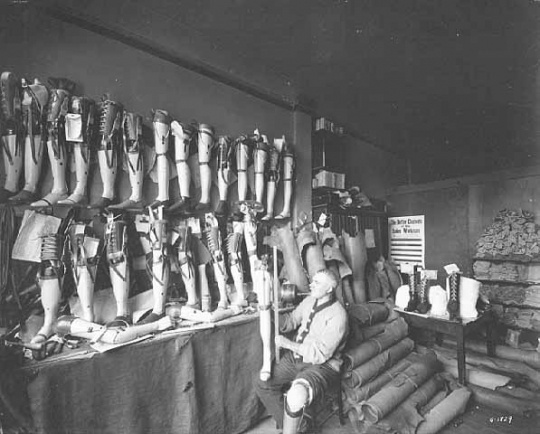
Artificial Limb Company, Minneapolis
Artificial Limb Company, Minneapolis, 1918.
Public domain
Holding Location
More Information
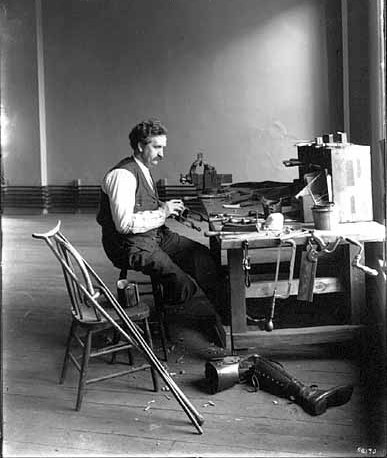
E. H. Erickson making artificial limbs
E. H. Erickson making artificial limbs, 1904.
Public domain
Holding Location
More Information
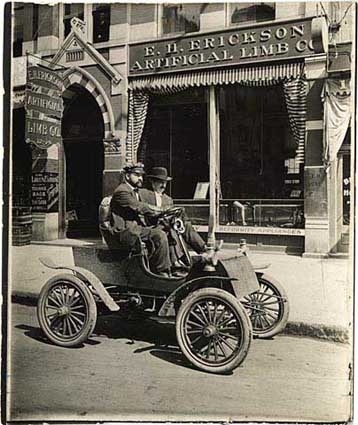
Michael Dowling and unidentified passenger in an automobile in front of E.H. Erickson Artificial Limb Company, Minneapolis
Michael Dowling and unidentified passenger in an automobile in front of E.H. Erickson Artificial Limb Company, Minneapolis, c.1905.
Public domain
Holding Location
More Information
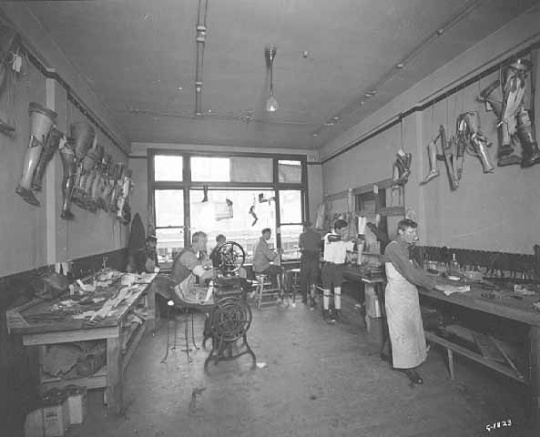
Artificial Limb Company, Minneapolis
Artificial Limb Company, Minneapolis. 1918.
Public domain
Holding Location
More Information
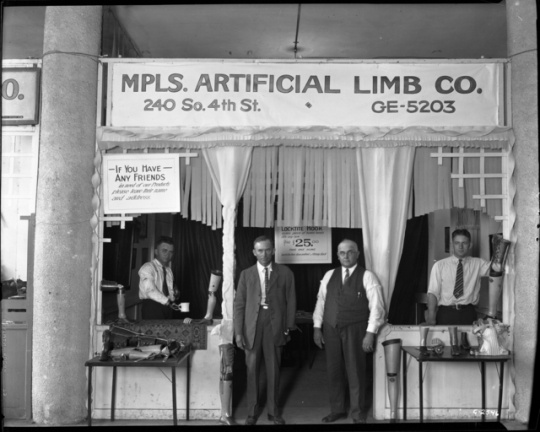
Minneapolis Artificial Limb Company at the State Fair
Minneapolis Artificial Limb Company at the State Fair, c.1922.
Holding Location
More Information
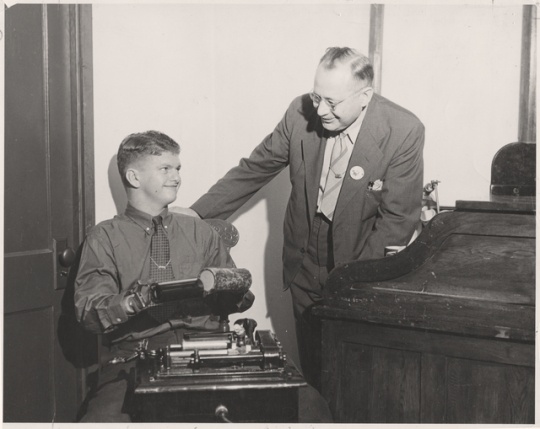
Training boy at Artificial Limb Company Minneapolis
Training boy at Artificial Limb Company Minneapolis, c.1930.
Holding Location
More Information
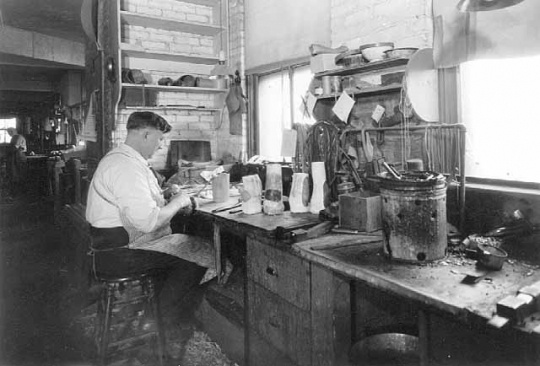
Winkley Artificial Limb Company, Minneapolis
Winkley Artificial Limb Company, Minneapolis, 1937.
Holding Location
More Information
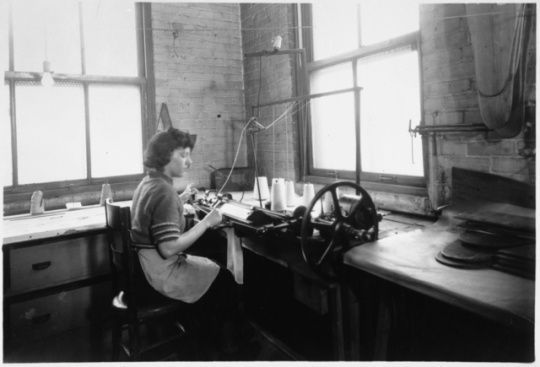
Knitting a sock to cover an amputated limb, Winkley Artificial Limb Company, Minneapolis
Knitting a sock to cover an amputated limb, Winkley Artificial Limb Company, Minneapolis, 1937.
Holding Location
More Information
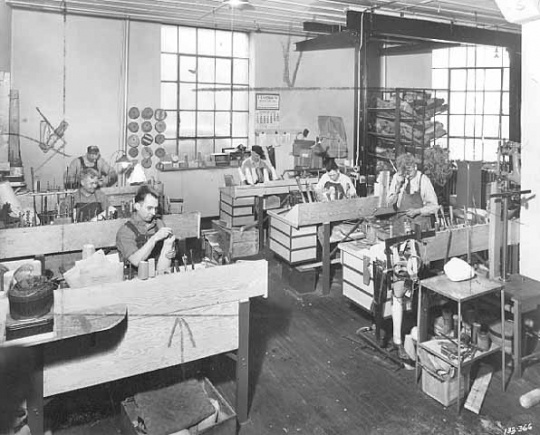
Work room, Minneapolis Artificial Limb Company
Work room, Minneapolis Artificial Limb Company, 1940.
Holding Location
More Information
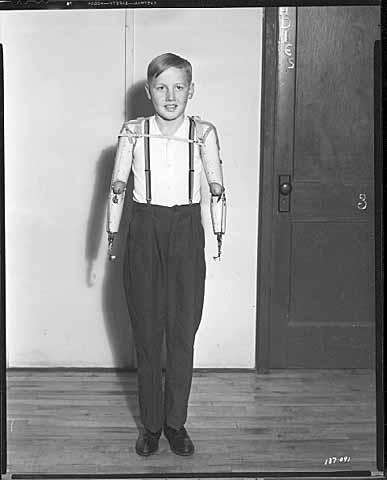
Boy with artificial arms
Boy with artificial arms, 1941.
Holding Location
More Information
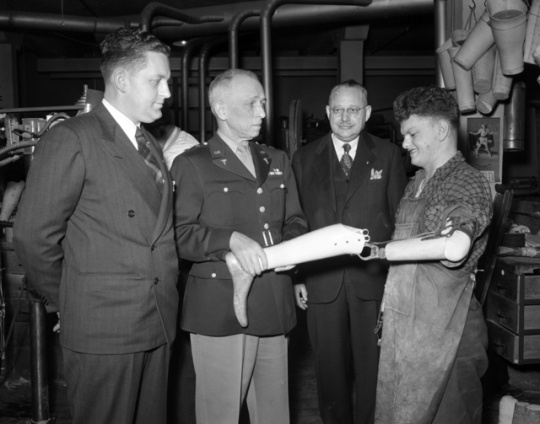
Major General Norman Kirk, Surgeon General of the Army, inspecting Minnesota-made artificial limbs
Major General Norman Kirk, Surgeon General of the Army, inspecting Minnesota-made artificial limbs, December 6, 1943.
Holding Location
More Information

Making artificial limbs at Minneapolis Artificial Limb Company, Minneapolis
Making artificial limbs at Minneapolis Artificial Limb Company, Minneapolis, 1945.
Holding Location
More Information
Related Articles
Turning Point
During the 1880s and 1890s, the large number of amputees in Minneapolis creates a need for artificial limbs.
Chronology
1868
c.1870s
c.1880s
1886
1888
1893
1917
1918
1938
1945
1957
2012
Bibliography
"A Study of Limbs." St. Paul Daily Globe, March 25, 1888.
http://chroniclingamerica.loc.gov/lccn/sn90059522/1888-03-25/ed-1/seq-14
"The Advertising of Artificial Limbs As a 'Peculiar' Business." Printers' Ink 97, no. 6 (May 9, 1918).
"Artificial Limbs." St. Paul Daily Globe, August 14, 1893.
http://chroniclingamerica.loc.gov/lccn/sn90059522/1893-08-14/ed-1/seq-6
Atkins, Annette. Creating Minnesota: A History from the Inside Out. St. Paul: Minnesota Historical Society Press, 2007.
Balch-Tullis Artificial Limb Company, Manufacturers of Air Cushion Limbs. Minneapolis: N.p., [1928].
Dregni, Eric, Mark Moran, and Mark Sceurman, eds. Weird Minnesota: Your Travel Guide to Minnesota's Local Legends and Best Kept Secrets. New York: Sterling Press, 2012.
Fuller, Jim. "Replacing the Irreplaceable: Twin Cities is a Center for Artificial Arms and Legs." Minneapolis Star Tribune, April 4, 1991.
"The Hobbling Brigade in Congress." New Ulm Weekly Review, February 24, 1886.
http://chroniclingamerica.loc.gov/lccn/sn89064939/1886-02-24/ed-1/seq-6
Linker, Beth. War's Waste: Rehabilitation in World War I America. Chicago: University of Chicago Press, 2011.
"Manual of Artificial Limb Lays Blueprint for A.A. Marks Company." Helio Orthotics/Prosthetics Business News, November 1, 2003.
http://www.healio.com/orthotics-prosthetics/prosthetics/news/online/%7B7226963C-D779-4273-A72E-EFA65467CDD5%7D/Manual-of-Artificial-Limbs-Lays-Blueprint-for-AA-Marks-Company
Ott, Katherine, David Serlin, and Stephen Mihm, eds. Artificial Parts, Practical Lives: Modern Histories of Prosthetics. New York: NYU Press, 2002.
Selcke, Taylor. "Twin Cities Firm to Make Historic Fitting of Prosthetic Hand." Minneapolis St. Paul Business Journal, January 11, 2012.
http://www.bizjournals.com/twincities/news/2012/01/11/otto-bock-michelangelo-hand.html
Warne, Vanessa. "Artificial Leg." Victorian Review 34, no. 1 (Spring 2008): 29–33.
——— . "'To Invest a Cripple with Peculiar Interest': Artificial Legs and Upper-Class Amputees at Mid-Century." Victorian Review 35, no.2 (Fall 2009): 83–100.
Related Resources
Primary
"Artificial Limbs: Hands Made with All the Flexibility and Usefulness of the Flesh and Blood Member." St. Paul Globe, September 6, 1902.
http://chroniclingamerica.loc.gov/lccn/sn90059523/1902-09-06/ed-1/seq-3
Assorted Business Files
Manuscript Collection, Hennepin County Library, Minneapolis
Description: On its second floor, separate from Special Collections, the Minneapolis Central Library has files of news clippings related to local companies. Many artificial limb companies, including the Minneapolis Artificial Limb Company, Winkley Artificial Limb Company, and Balch-Tullis Company, have files.
P1559
Joseph Goiffon autobiographies, [undated], 1861, 1908
Manuscript Collection, Minnesota Historical Society, St. Paul
Description: Reverend Goiffon had both feet amputated after being caught in a blizzard during the winter of 1860. His autobiography addresses the incident and life afterward. Also see microfilm collections filed under M6.
Lowell E. Jepson Biographical Clippings, 1863–1938
Manuscript Collection, Hennepin County Library, Minneapolis
Description: Newspaper clippings pertaining to Lowell E. Jepson, the founder of Winkley Artificial Limbs.
Lucius G. Trautman Obituary File, 1907–1970
Manuscript Collection, Hennepin County Library, Minneapolis
Description: Obituary clippings about Lucius G. Trautman, president of the Minneapolis Artificial Limb Company and son of the company's founder.
M411
Michael J. and Jennie B. Dowling Papers, 1883–1944
Manuscript Collection, Minnesota Historical Society, St. Paul
http://www2.mnhs.org/library/findaids/00915.xml
Description: Biographical and career information about Michael Dowling, a prominent Minnesota politician and banker. Dowling used artificial limbs after losing both legs, one arm, and part of his remaining hand to frostbite as a teenager.
Minneapolis Artificial Limb Company. Minneapolis: N.p., 1919, 1920.
"New Corporations." St. Paul Daily Globe, March 15, 1889.
http://chroniclingamerica.loc.gov/lccn/sn90059522/1889-03-15/ed-1/seq-4
Price, Mina B. "Made in Minneapolis: Artificial Limbs." Minneapolis Journal Junior, May 23, 1903.
"Reconstructing the Wounded." Warren Sheaf, June 11, 1919.
http://chroniclingamerica.loc.gov/lccn/sn90059228/1919-06-11/ed-1/seq-4
Trautman Intl. Artificial Limb Co., February 1945
Manuscript Collection, Hennepin County Library, Minneapolis
Description: One newspaper clipping related to the formation of the Trautman International Artificial Limb Company. The new company was a joint international effort between the Minneapolis Artificial Limb Company, founded by Ray Trautman, and the Dennis R. Scanlan Corporation of Sweden. The new plant in St. Paul was managed by Lucius Trautman, Ray Trautman's son.
"Wholesale Trade: How it Has Grown Up in Minneapolis From Small Beginnings." Minneapolis Journal, November 26, 1903.
http://chroniclingamerica.loc.gov/lccn/sn83045366/1903-11-26/ed-1/seq-104
St. Paul Artificial Limb House. From the Surgical to the Mechanical Art: Life-like Artificial Arms and Legs. [St. Paul: St. Paul Artificial Limb House, 1902?].
Winkley Artificial Limb Company catalog and ephemera
Hennepin History Museum, Minneapolis
Description: Includes a catalog, large poster, and other ephemera related to the Winkley Artificial Limb Company.
Secondary
Herschbach, Lisa. "Prosthetic Reconstructions: Making the Industry, Re-Making the Body, Modeling the Nation." History Workshop Journal 44 (Autumn 1997): 22–57.
Reznick, Jeffrey S. "Beyond War and Military Medicine: Social Factors in the Development of Prosthetics." Archives of Physical Medicine and Rehabilitation 89 (January 2008): 188–193.
Sellegren, Kim R. "An Early History of Lower Limb Amputations and Prostheses." Iowa Orthopedic Journal 2 (1982): 13–27.
http://www.ncbi.nlm.nih.gov/pmc/articles/PMC2328816/pdf/iowaorthj00032-0015.pdf
Web
"Michael J. Dowling Silent Film." Collection Up Close Podcast and Blog, Minnesota Historical Society, St. Paul, June 24, 2011.
http://discussions.mnhs.org/collections/2011/06/michael-j-dowling-silent-film/
Winkley Orthotics and Prosthetics. History.
https://www.winkley.com/about
Winkley Orthotics and Prosthetics. Original Winkley Catalog (PDF).
http://www.winkley.com/index.php/download_file/view/337/78/













